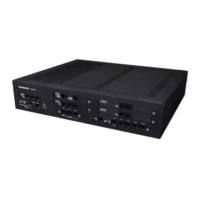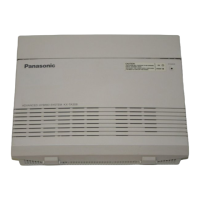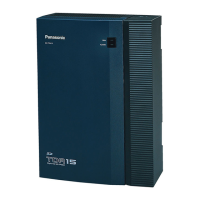Common Extension Numbering for Multiple PBXs
Multiple PBXs in separate locations, connected in an IP network, can share a common block of extensions
designated in a gateway group.
Extn. 203
Extn. 202
Extn. 102
Extn. 303
Extn. 201
Extn. 105
Extn. 104
Extn. 103
Extn. 101
PBX B in Office B
1) Extn. 105 dialed
PBX C in Office C
2) Extn. 105 not
found in PBX B
3) Rerouted
4) Check next PBX in
Gateway Group settings
5) Extn. 105
found in PBX C
PBX A in Office A
V-IPGW
V-IPGW
V-IPGW
Private IP
Network
Explanation:
In the same way as when connected by a TIE Line, if a dialed number is not found at the local PBX, the call
can be sent to other PBXs connected via an IP network. When an extension number is dialed, the PBX first
searches local extensions for a matching number. If there is no match, the PBX then checks the TIE Line
Routing Table for the Gateway Group for a corresponding entry. If an entry is found, the call is sent to the
connected PBX.
Automatic Rerouting of VoIP Calls to Public CO Lines
When a VoIP call
cannot be completed successfully, the PBX can automatically attempt to make the call using
a public CO line instead. This provides a backup method of making calls in cases when IP network transmission
cannot be completed successfully.
[Example]
PBX-1 PBX-2
Extn.1000
Extn.1011
(333-123-1011)
IP-GW IP-GW
Dials
"7-20-1011".
Private IP
Network
Telephone Company
(area code: 222)
Telephone Company
(area code: 333)
PBX code: 20PBX code: 30
1-333-123-1011
The leading numbers of extensions accessed through the VoIP network are added as entries to the Quick
Dialing table, in addition to being registered as Other PBX Extension Numbers, as shown below:
[Programming Example]
Number to dial to call an extension at another PBX using VoIP network:
7 (TIE line access number) + 20 (PBX Code) + 1011
(extension number)
284 Feature Manual Document Version 2013-05
13.1.26 Private Network Features—VoIP (Voice over Internet Protocol)

